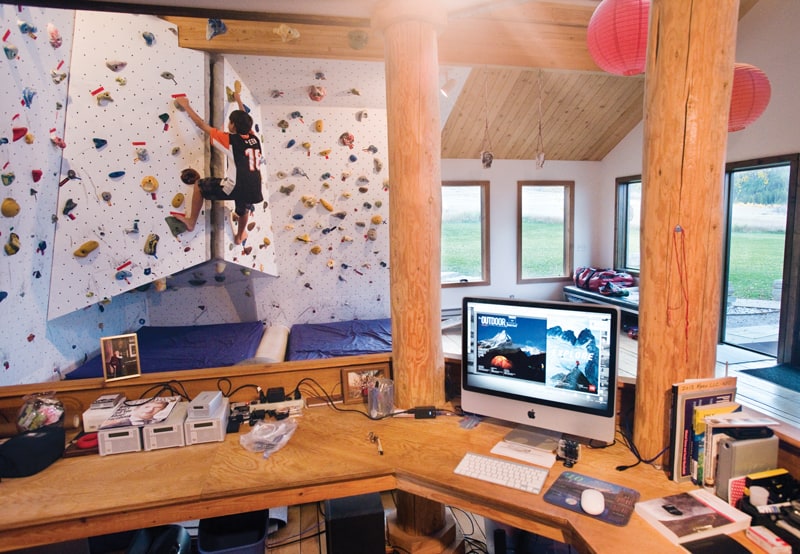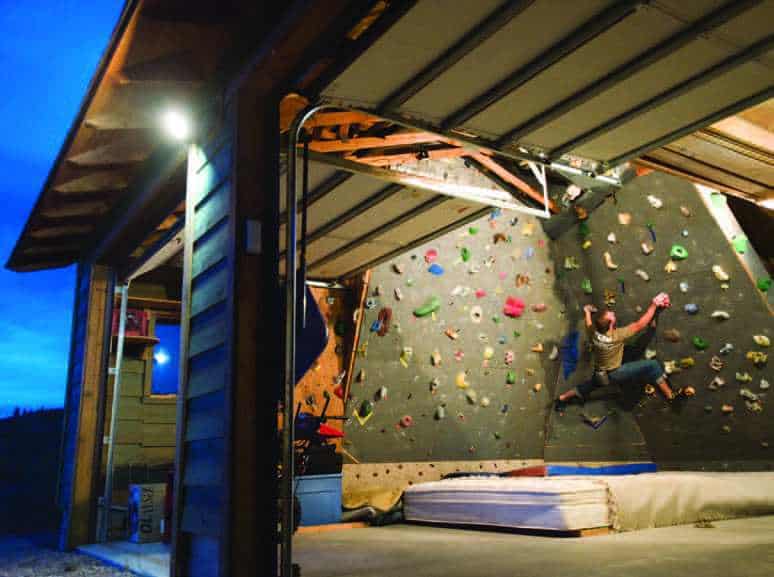Read The
Current Issue
Climb On
Some home gyms here aren’t what you’d expect.
BY MOLLY ABSOLON
PHOTOGRAPHY BY BRADLY J. BONER

THE FIRST CLIMBING wall I ever saw was a “woodie,” built by Todd Skinner and friends in his garage in Lander, Wyoming. The handmade wooden holds had names—Ollie, Fat Boy, Moo, Zeus, and The Bavarian, which was shaped like a beer stein filled to the brim with foam—and you climbed routes according to a sequence of names: Ollie and Monte to Lumpy, throw to Thuggish, ending on Persevere.
The woodie covered one wall of the garage and slanted out at a steep angle over old, dusty mattresses piled up on the floor. Climbers gathered there to train, hang out, egg each other on, and get strong.
I visited Skinner’s gym in 1992. It was early in indoor climbing’s evolution in the United States. The first commercial indoor gym—Vertical World—opened its doors in Seattle in 1987. Europeans had been training inside for a lot longer.
BRITISH CLIMBER DON Robinson is credited with creating the first indoor climbing wall in the mid-1960s. He watched a lot of his friends get hurt in the spring when they jumped from the couch onto the crags and decided it made sense for climbers to train in the off-season to avoid injury. He glued nubbins of rocks onto a brick wall in a hallway at Leeds University so people could rehearse climbing moves when the weather went south. His idea caught on outside of Leeds after a relative beginner named John Synett climbed an area test piece on his first try, shocking the climbing world. Synett said his success stemmed from the training he’d done on Robinson’s wall. The message was heard loud and clear, and by the 1980s, climbing gyms were common across Europe.

AROUND JACKSON HOLE, the rock-climbing season is short, and most crags are inaccessible or unpleasant once the temperatures drop and the snow flies. Climbers here have few options for staying in shape. (The only commercial climbing gym in the valley, Enclosure, closed its doors in early September.) As a result, many serious climbers in Jackson Hole create some way to train in their homes. For many, this means little more than placing a few fingerboards over doors to hang on or do pull-ups. Others have more elaborate creations.
Grand Teton National Park climbing ranger Rich Baerwald and retired Park Service ranger Maura Longden have built lots of climbing walls over the years. They moved around for their jobs and often lived far from good outdoor crags, so they’d create something to train on wherever they were. “We had one in Alaska we called the Alaska cave,” Baerwald says. “We joked that it was the best climbing in the Yukon, but basically there is no climbing in the Yukon.”
Baerwald says these earlier creations were practice runs for the penultimate one he constructed last winter in his garage in Victor, Idaho. He and Longden had grown weary of digging their cars out of the snow in the winter, so they decided to build a garage. From the outset, there was no question that building a garage meant building a gym. “We are climbers, and when we thought of building something as big as a garage, a climbing gym was part of the vision. It was kind of like, ‘Oh and by the way, we can park our cars in here when it snows, too,’ ” Baerwald says.
“We wanted the gym to look good. We wanted it to be inviting, wanted warm colors in the winter months—that’s why it’s painted red, like desert rock.
“It’s a good place for contemplation. You come out here and get away from the stress of the world. I turn up the music and start bouldering around. Before you know it, an hour has gone by.”
The aesthetics of Baerwald and Longden’s gym were important to them. They knew that if they just put holds on a plywood board in a cold, dark basement, they’d never use the wall. Their garage gym is heated, has big windows to let in natural light, and comes with a high-quality sound system that fills the space with music. The walls are painted rusty red and a rich cream color that together evoke a sense of the sandstone cliffs of canyon country. Walls are tall and set up so you can either practice lead climbing or boulder without a rope. A loft above provides space for the pair to work out and practice yoga.
ACROSS THE VALLEY near the base of Teton Pass, mountain guide and Jackson Hole High School science teacher Trevor Deighton also has a climbing wall in his garage. Like Baerwald and Longden, the wall was part of Deighton’s vision before his home was built. To enable the garage to fulfill its double duty as climbing gym and parking area, a friend of Deighton’s designed platforms for the mattresses that cushion climbers from falls. These platforms can be raised high enough to allow a car to park underneath.
Deighton’s wall was a community effort. Friends pitched in money to buy the plywood, lumber, and holds and provided labor to build the actual wall. To save money, they dismantled an old climbing gym from another garage and salvaged parts. All told, Deighton thinks he spent about $2,000 building his climbing gym.
“At the time there was really no other outlet for climbers and guides in the winter,” Deighton says. “We used to come in here after work or after skiing. It was a great way to relax and see friends and get in a workout.”
Deighton’s design fell together more spontaneously than Baerwald and Longden’s. He talked to friends who told him to avoid having any vertical sections and not to bother with elaborate features or walls overhanging more than thirty degrees. The result is a fairly simple design that provides excellent off-season training, although Deighton concedes he uses it less these days than in the past. “Some of my climbing friends have left the area,” Deighton says. “I don’t really climb out here much on my own. But kids love it, and it’s fun when friends are in town.”
PROFESSIONAL CLIMBER AND photographer Jimmy Chin’s indoor climbing area was built with aesthetics as a guiding principle. This is understandable since he doesn’t have a garage. Chin’s climbing wall is in the corner of his bedroom/office, a large, open room that features a three-sided desk beneath a towering sleeping loft.
Chin built his gym with the help of friend Jimmy Hartman. Hartman says they spent long hours figuring out what they wanted and creating it, particularly a concrete crack, which they call the Bachar Cracker after a famous boulder problem in Yosemite National Park. To complete that feature the two men pulled an all-nighter. They used concrete to make the hand crack, which severs the prow of an arête. A short overhang provides a quick pump.
“The winters are long in Victor and Jackson,” Chin says. “So I wanted something easily accessible to train on. I love climbing, so it’s fun to have a wall to hang on and move around on during the winters.”
If Chin wants to, he can scramble out of his bed in the loft and start climbing. His desk, which sits under the loft, also provides quick access to the wall. When he needs a break from work, he can grab a hold and be moving. “Jimmy uses [the gym] all the time when he is home,” Hartman says. “He’ll boulder around with a hands-free headset on, talking to clients.”
DIY
DO-IT-YOURSELF climbing gyms can cost as little as a couple hundred dollars for a few holds on a piece of plywood to thousands of dollars for elaborate features, commercial panels molded into rock-like shapes, textured coatings, and bigger spaces.
But you can start simple. Don Robinson’s first climbing wall was created by inserting and gluing pieces of rock into a brick wall. Todd Skinner’s woodie was built with scrap lumber and holds made by gluing layers of thin plywood into blocks, then sanding and smoothing them into interesting shapes.
Commercial plastic or silicon holds are available from a number of companies, with Metolius being the original manufacturer. Holds typically come in bundles, with prices varying according to size. A pack of five extra-large holds usually starts at around $75. Twenty small, simple holds run closer to $50. The most versatile option for starting out is to get combination packs of holds in assorted sizes. This will give you the most variety and helps keep your climbing wall entertaining. You may be able to pick up used holds on the Internet or from people who are dismantling their home gyms.
When selecting holds, be sure to consider the texture. Holds can be hard on your skin, particularly some older styles. Yes, these rough holds are grippier, but they feel like sandpaper and can leave your fingers red and sensitive after a few rounds. Your best bet is to read reviews or talk to people about different finishes. Smoother holds feel slippery and insecure but don’t beat you up as much.
The number of holds you’ll need depends on the size of your space. In general, the more holds, the more climbing options you’ll have and the longer the wall will retain its interest. For a bouldering wall, experts recommend thirty-two holds per one 4’ x 6’ sheet of 3/4-inch plywood. You can get screw-on holds or bolted holds, although most people like the bolted variety because they are easier to move when you want to change your routes.
Other options include angles, steepness, and landings. How you combine these usually depends on your climbing objectives and experience. Rich Baerwald says he tried to avoid steep overhangs because his goal was to promote fluid movement and ensure his climbing longevity. If you’re looking purely for strength training, you may want to go with big roofs to get a quick pump.
The Internet has numerous sites offering instruction and ideas for constructing your own gym. You can peruse photographs, blueprints, and step-by-step instructions.
Good sites include:
1. metoliusclimbing.com/pdf/How-to-Build-a-Home-Climbing-Wall.pdf
2. atomikclimbingholds.com/how-to-build-a-rock-climbing-wall
3. chockstone.org/TechTips/Woodie.htm




